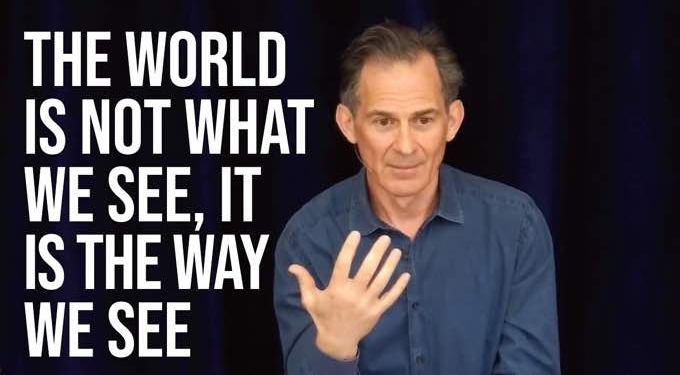Source: Rupert Spira
Do we see reality the way it really is? A man asks how to break down the illusion of duality— maya — that is taught to us in the materialist paradigm. Rupert replies that it is important to understand that the actual experience of seeing does not change — the Buddha would see the same appearance we see. Thus, it is not the illusion that disappears after awakening to the truth of the nature of reality, it is the ignorance — ignoring the one reality and imagining it is two: self and other, seer and seen.
Don't try to break the illusion down, try to break the ignorance down. As long as we are alive, and embodied, we experience the world through the senses. It will always appear as a multiplicity and diversity of objects and selves at a distance from ourself. The appearance remains, but your interpretation of the appearance changes as the old model of subject-object, self and other, is replaced with this new model of unity and oneness — that all is the one shared being. Once you have that understanding, you look back at the world and see through the appearance. The appearance doesn't change, but it becomes transparent. The world is not what we see, it is the way we see.
TRANSCRIPT:
Q. Hi Rupert. I wanted to ask three things. And the first is about deepening the understanding through the tantric path. It seems in my experience that certain glimpses are stronger than others – that sometimes I understand the understanding much much deeper. And this happens when often I'm exploring the senses. And one thing I found difficulty in is that certain senses are harder to examine than others. So, for instance, sensations seem to be clearer, and then hearing slightly more difficult. But when it gets to sight and then thoughts, it seems much harder.
So I'm wondering why are these different senses seem to be more difficult to examine and how to approach deepening this examination of them?
Rupert Spira: The reason that seeing is probably the most difficult of the senses to explore is because the illusion of otherness, the illusion of duality, is at its most persuasive in the experience of seeing.
It's relatively easy to close your eyes, give your attention to the experience of hearing and realize, and understand experientially that all there is to hearing is knowing, is consciousness.
It's more difficult with seeing because seeing seems to divide reality into two parts: a subject that sees, and a world at a distance from ourselves that is seen. So the illusion of separation, Maya, is at its most persuasive when it appears to us through the faculty of seeing. And one thing that's important to understand is that the actual experience of seeing doesn't change.
If the Buddha was sitting here with us now Meister Eckhart, or Ramana Maharshi – they would be seeing exactly the same appearance as we would. It's not the illusion that disappears. It's the ignorance that disappears. What do I mean by ignorance? I don't mean stupidity. I mean ignorance in the sense of ignoring the one reality, imagining that it is two: self and other, seer and seen.
So it's not important for the experience of seeing to change. What's important is for the concepts that we superimpose onto the experience of seeing to dissolve through understanding.
What we experience as the world is a relationship between two aspects of the one whole, the one reality locates itself as a viewpoint that is each of us. And the interaction of this viewpoint in the one reality and the rest of the reality appears from the perspective of this viewpoint, this finite mind, as the universe.
So what we know of the world is an interaction between these two segments of reality. They're not really two separate segments. The finite mind, this viewpoint, is just a localization of the one, made of the one, appearing in the one, from whose point of view it interacts with the unlocalized aspect of itself. And it's the interaction between these two elements that create the appearance of the world.
It doesn't create the reality of the world. The reality of the world is there before it is perceived. But it appears as the world when it is perceived: half created, half perceived.
Q. And how might one go about breaking this illusion down through sight or through = thoughts?
Rupert Spira: Don't try to break the illusion down. Try to break the ignorance down. The illusion remains. As long as we are alive, and embodied, we experience the world through the senses. It will always appear as a multiplicity and diversity of objects and cells at a distance from ourselves. Don't try to break down the illusion. The illusion remains. It's the ignorance that goes. So the appearance remains, but your interpretation of the appearance changes.
From a conventional point of view, the way we interpret this appearance of the world is that I, this little package of consciousness, is temporary and finite. It was generated by my brain and lives just behind my eyes. And everything that it knows or perceives is separate from and other than myself. That's the conventional interpretation of this appearance. What changes is the interpretation, not the appearance.
So I've just given you a new interpretation of this appearance. The appearance remains intact, but this new interpretation replaces the old model of subject, object, self and other. With this model of unity, of oneness, shared being. Then, once you have that understanding you look back at the world and you see through the appearance. The appearance doesn't change, but it becomes transparent.
Previously you just saw the landscape in the movie, which was a multiplicity and diversity of objects. There seemed to be ten thousand things in the movie. Now you see through the landscape. You see the one screen. What enables you to do that? This new understanding.
So, it's as if the appearance of the world is normally opaque. We think there are 10 000 things there. And with this understanding, the same appearance simply becomes transparent. We see, so to speak, through it. Remember the 16th century English poet George Herbert:
“Teach me my God and King in all things Thee to see. And what I do in anything to do it as for thee. A man may look on glass, on it stay his eye; Or, if he pleaseth, through it pass, and then may heaven espie.”
A man or person may look at the world and see ten thousand things. Or if they please, they can see through that appearance, and then may heaven espie. That is the ultimate reality of the universe. This life's dim windows of the soul distorts the heavens from pole to pole and leads us to believe a lie when we see with, not through the eye. This life's dim windows of the soul, perception, seeing – distorts the heavens from pole to pole. Distorts the reality of the universe and makes it appear as ten thousand things.
So you see: the world is not what we see, it is the way we see. What we see doesn't change. The way we see changes. And when the way we see changes, even what we see changes. And what we see really confirms the way we see. If we believe in separation, the world will appear as a multiplicity and diversity of objects. If we understand and feel the unity of being, the world which once seemed to conceal its reality will now shine with it.
I can't resist telling my favorite Blake story, which many of you know by heart. Blake was having a conversation with exactly the same conversation with one of his friends. No, not the same because this was a die-hard materialist, and you certainly aren't. Anyway, he was trying to explain this to one of his friends.
His friend said to him: Do you mean to say that when you see the sunrise you do not see a round disc of fire – somewhat like a Guinea (a coin).
And Blake replied: Oh, no, no, no. I see an innumerable company of the heavenly host crying ‘Glory, glory, glory is the Lord God Almighty.”
















